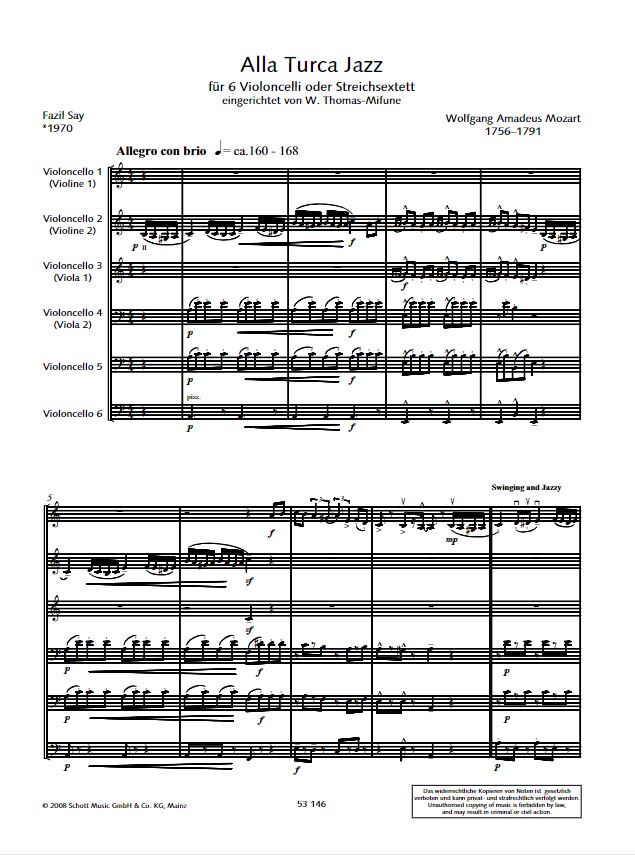
Happy Present Meet
Mozart - Say Alla Turca Jazz for 6 Cellos (or String Sextet)
Fantasia on the Rondo from the Piano Sonata in A Major, K.331 by Mozart arranged by Fazil Say
String Sextet or Cello Ensemble
Score and parts
Difficulty: intermediate to advanced
Performance duration: 4`0"
Urauffuhrung : 2007 Lorrach, Burghof (D) · Philharmonische Cellisten Koln
Turkish pianist and composer Fazil Say (b. 1970) arranged this piece as an effective encore for piano. In this edition, it is arranged for six cellos (or string sextet).
Alla Turca Jazz
Fantasia on the Rondo from the Piano Sonata in A major K. 331 by Wolfgang Amadeus Mozart
The final movement of the Sonata in A major KV 331 by Wolfgang Amadeus Mozart, the Rondo Alla Turca, is one of the most famous piano pieces of all time. Once only familiar to musical experts, later a universal piece for all piano pupils, its opening melody is now even omnipresent as an alienated sinus tone-like mobile phone ring tone.
Fazıl Say's arrangement, originally created as an effective encore, follows on from this popularity. After the first eight bars have been presented in original form, typical elements of jazz superimposed on the still recognisable classical foundations can be discovered, such as syncopation of the top notes and ornamentation through chromatic blue notes, embedded in the at times frenzied chains of semiquavers. In the spirit of the work's improvisatory character, Say likes to perfom his Alla Turca Jazz in different combinations, for example accompanied by jazz singers of with orchestra.
It may appear strange that Fazıl Say, who was born in Turkey and - when not on tour - is still resident in that country, does not bring back Mozart's interpretation of genuine Turkish music closer to its own roots, particularly as many of his compositions such as Black Earth or the Violin Sonata are characterised by a subtle amalgamation of the Classical-Romantic tradition, Turkish folk music and elements of jazz. In a further Mozart arrangement, the ballet music Patara premiered in Vienna in 2006, composed on the basis of the Rococo-like theme from the first movement of the same A-major Sonata (which enjoys almost as great popularity as the Alla Turca theme), Say utilised the connection which was absent in Alla Turca, albeit in the opposite direction. In the ballet music, the piano symbolises Western culture and the Ney flute Oriental culture, communcated atmosperically by austere percussion instrumentation and soprano vocalisation.
알라 투르카 재즈
볼프강 아마데우스 모차르트의 피아노 소나타 A장조 K. 331번 론도에 의한 환상곡
볼프강 아마데우스 모차르트의 피아노 소나타 A장조 KV 331번의 마지막 악장인 알라 투르카 론도는 역사상 가장 유명한 피아노 곡 중 하나입니다. 한때는 음악 전문가들만 알고 있었지만, 이후 모든 피아노 학생에게 보편적인 곡이 된 이 곡의 첫 멜로디는 이제 마치 휴대폰 벨소리처럼 소외된 사인파처럼 어디에나 존재합니다.
원래 효과적인 앙코르로 제작된 파질 세이의 편곡은 이러한 인기를 이어갑니다. 처음 여덟 마디가 원곡 형태로 연주된 후, 여전히 알아볼 수 있는 고전적인 기초 위에 재즈의 전형적인 요소들이 겹쳐진 모습을 발견할 수 있습니다. 최고음의 싱코페이션과 반음계적 청음으로 이루어진 장식음은 때때로 광란적인 16분음표의 연쇄에 녹아들어 있습니다. 즉흥 연주라는 작품의 특성에 따라, 세이는 자신의 알라 투르카 재즈를 재즈 가수나 오케스트라 반주 등 다양한 조합으로 연주하는 것을 즐깁니다.
터키에서 태어나 투어 중이 아닐 때는 여전히 터키에 거주하는 파질 세이가 모차르트의 정통 터키 음악 해석을 그 뿌리에 더 가깝게 되살리지 않는 것은 이상하게 보일 수 있습니다. 특히 그의 많은 작품, 예를 들어 검은 땅이나 바이올린 소나타는 고전-낭만주의 전통, 터키 민속 음악, 그리고 재즈 요소를 미묘하게 융합한 것이 특징이기 때문입니다. 모차르트의 또 다른 편곡으로는 2006년 비엔나에서 초연된 발레 음악 파타라가 있습니다. 이 작품은 같은 A장조 소나타 1악장의 로코코풍 주제를 바탕으로 작곡되었는데, 이 주제는 알라 투르카 주제만큼이나 큰 인기를 누리고 있습니다. 세이는 알라 투르카에는 없었던 연결성을, 비록 반대 방향이기는 하지만, 활용했습니다. 발레 음악에서 피아노는 서양 문화를 상징하고, 니플루트는 동양 문화를 상징하며, 엄격한 타악기 연주와 소프라노 보컬을 통해 분위기 있게 전달됩니다.
편곡자 Say, Fazil
작곡가 Mozart, Wolfgang Amadeus(1756-1791)
에디터 Thomas-Mifune, Werner
